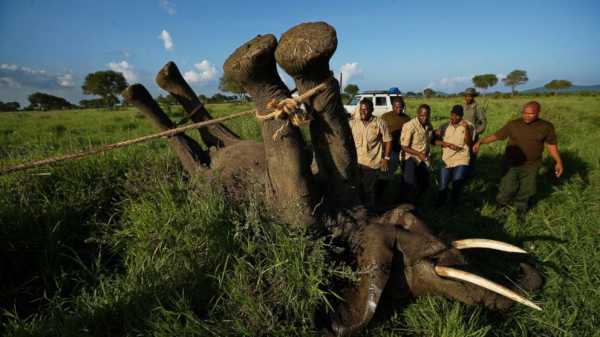
The elephant fell into the tall grass in Tanzania, where some of the worst in the world poaching has occurred.
It is not murderers who targeted her, but officials guard shot her with a dart drug. Soon she was snoring. They slid to 26 pounds (12 kg) GPS tracking collar and the antidote to bring her back to her feet.
The operation was part of an annual effort to track 60 elephants in and around the Selous game reserve nature reserve in Tanzania, widely known as “ground zero” in poaching, which decimated Africa’s elephants. The associated Press went there to see how the battle to save them is gaining momentum, with murders declining, and some populations are growing again. Legal ivory markets are declining worldwide and law enforcement agencies broke up some of the trafficking syndicates, experts say.
But it’s too early to declare a turnaround. The poachers are moving to a new site and traders adapt and contribute to the corruption. The value of annual losses, the elephant still exceeds the birth rate. And encroachment of human settlements reduces the range of animals.
“We have a long way to go before we can feel comfortable about the future,” said Chris taules in the preservation of elephants, a group based in Kenya, where elephant numbers are rising.
Britain this month announced a ban on the sale of ivory. In China, the ivory trade is illegal, since this year. In the US, the ban on ivory in addition to subjects older than 100 years of steel in 2016.
If poaching can be brought under control in Tanzania, there is hope that the killing can be stopped throughout Africa.
Elephant population in Africa has plummeted from millions in 1900 to, at least today 415,000. Started a ban on commercial trade in ivory across international borders in 1990, but many countries continue to allow internal trade.
Demand growth in China has caused a new wave of murders. The population of the African elephant Savannah fell by 30 percent between 2007 and 2014, approximately 352,000, according to the census.
Tanzania’s elephant population fell by 60 percent to 43 000 in the period between 2009 and 2014, according to the government. Biggest massacre took place in the selous-Mikumi ecosystem.
The killing seems to have slowed. The number in the Selous-Mikumi last year added up to 23 carcasses, 20 percent of the number found four years ago. And the poaching of African elephants has dropped to pre-2008 levels after peaking in 2011, in accordance with the Convention on international trade in Endangered species.
This is a positive trend, but there is speculation that many of the districts have fewer elephants to kill.
“All” lightweight “dead elephants,” said drew McVey, East Africa Manager of WWF for nature protection.
In the region of the Selous game reserve in Tanzania, more visible and newborn elephants elephants move more widely outside of formally protected areas, said Edward Koch, chief scientific officer of the research Institute of wildlife of Tanzania and the head of the world wildlife Fund accumulation program’s GPS tagging.
Poaching of elephants, will likely never be eradicated, Qax recognized.
When the income from the illicit trade in ivory is made in the same area, killing to intensify in another. International seizures of smuggled ivory appears to be as big as ever, a possible sign of efforts of drug dealers to move inventory before the business becomes too difficult.
Matter of grave concern and evidence of increased processing of bones for jewelry and accessories in Africa that allows merchants to transport ivory in smaller, difficult to detect quantities.
Vast deserts of Tanzania still gives hope to the world’s largest land animals.
In 50 to 100 years, Koch said, “when the human population is growing rapidly, it will be one of the most important areas for the conservation of elephants.”
—
Follow Christopher books on Twitter www.twitter.com/torchiachris
Sourse: abcnews.go.com






